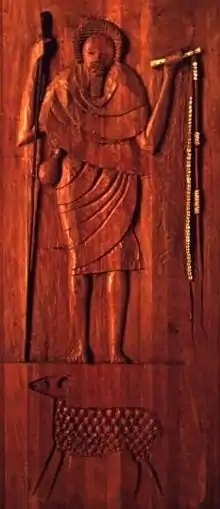Oko (orisha)
Oko, also known as Ocô in Brazil,[1][2][3] was an Orisha.[4] In Nigeria and the Benin Republic, he was a strong hunter & farming deity as well as a fighter against sorcery. He was associated with the annual new harvest of the white African yam. Among the deities, he was considered as a close friend of Oosa, Ogiyan and Shango, as well as a one time husband of Oya and Yemoja. Bees are considered the messengers of Oko.[5]
| Oko | |
|---|---|
Agriculture, Farming, Fertility | |
| Member of Orisha | |
 | |
| Other names | Ocó, Òrìṣàokó |
| Venerated in | Yoruba religion, Dahomey mythology, Vodun, Santería, Candomblé |
| Color | red , and white |
| Region | Nigeria, Benin, Latin America |
| Ethnic group | Yoruba people, Fon people |
In Brazilian Candomblé, he represents one of the Orisha of agriculture, together with Ogum.[6] According to Prandi, Oko songs and myths are remembered, but the presence in celebrations is rare.[7] In his representation, he had a wooden staff, plays a flute of bones and wears white.[8] Oko is syncretized with Saint Isidore among Cuban orisha practitioners of Santería (Lucumí) and Regla de Ocha.[9][10]
Notes
- Comissão Catarinense de Folclore 1953, p. 51.
- Ianamá 1984, p. 79.
- Prandi 2017.
- Adeoye 1989, pp. 270–279.
- Vogel 1981, p. 96.
- Prandi 2005, p. 103.
- Prandi 2005, p. 118.
- Amado 2012.
- De La Torre 2004, p. 81.
- Marra & Grassi, p. 20.
References
- Prandi, Reginaldo (2017). Aimó: Uma viagem pelo mundo dos orixás (in Portuguese). Editora Seguinte. p. 200. ISBN 978-8543809670.
- Amado, Jorge (2012). Bahia de Todos-os-Santos (in Portuguese). Companhia das Letras. p. 400. ISBN 978-8580864298.
- Boletim trimestral (in Portuguese). Comissão Catarinense de Folclore, Instituto Brasileiro de Educação, Ciência e Cultura. 1953. p. 118.
- Espaço-Orixá-Sociedade: arquitetura e liturgia do candomblé (in Portuguese) (2nd ed.). Ianamá. 2004. p. 84. ISBN 8585151013.
- Vogel, Susan Mulli (1981). For Spirits and Kings: African Art from the Paul and Ruth Tishman Collection. New York: Harry N. Abrams, Inc, NY. p. 256. ISBN 0870992678.
- Adeoye, C. L. (1989). Ìgbàgbọ́ àti ẹ̀sìn Yorùbá (in Yoruba). Ibadan: Evans Bros. Nigeria Publishers. pp. 270–279. ISBN 9781675098.
- Marra, Sandrino Luigi; Grassi, Valentina. QUEL CHE RESTA DEL VODU. Lulu.com. ISBN 9781326334086.
- De La Torre, Miguel A. (2004). Santeria: The Beliefs and Rituals of a Growing Religion in America (in Spanish). Wm. B. Eerdmans Publishing. p. 246. ISBN 0802849733.
- Prandi, J. Reginaldo (2005). Segredos guardados (in Portuguese). Companhia das Letras. p. 328. ISBN 9788535906271.